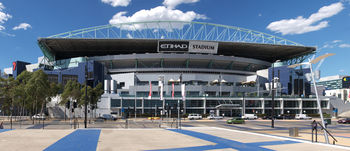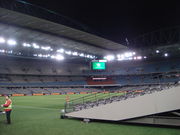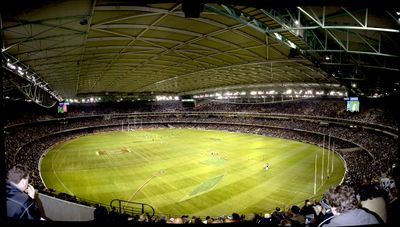Docklands Stadium
| Docklands Stadium | |
|---|---|
| Etihad Stadium | |
 |
|
| Former names | Colonial Stadium Telstra Dome |
| Location | Harbour Esplanade, Melbourne Docklands |
| Broke ground | 1996 |
| Opened | 9 March 2000 |
| Owner | James Fielding Funds Management |
| Operator | Melbourne Stadiums Limited Access One |
| Surface | Grass |
| Construction cost | AU$460 million |
| Architect | Daryl Jackson Architects and Hok Sport Architecture[1] |
| General Contractor | Baulderstone Hornibrook |
| Capacity | 53,359 (Seating Capacity) 56,347 (Venue Capacity) |
| Tenants | |
| AFL: Carlton Football Club (2005 - present) Essendon Football Club (2000 - present) North Melbourne Football Club (2002 - present) St Kilda Football Club (2000 - present) Western Bulldogs Football Club (2000 - present) A-League: Melbourne Victory (2006 - present) NRL: Melbourne Storm (2001) |
|
Docklands Stadium (also known by its former sponsored names as Colonial Stadium, Telstra Dome and currently known as Etihad Stadium), is a multi-purpose sports and entertainment stadium in the Docklands precinct of Melbourne, Victoria, Australia. Construction started in October 1997 under the working name, "Victoria Stadium" [2] and was completed in 2000 at a cost of AU$460 million.
Originally built as a replacement for Waverley Park, the stadium is primarily used for Australian Rules Football (AFL) and is the headquarters of the Australian Football League who, as part of the construction deal, assume ownership of the ground in 2025. Also headquartered at the stadium is Seven Network's digital broadcast centre.
The stadium has been host to other sporting events, including regular football (soccer) matches (as blockbuster matches of Melbourne Victory), one-off matches for sports including cricket, rugby league and rugby union, and several specialised events and concerts.
The stadium has been controversial since its first construction and there has been a significant amount of criticism directed toward the facility, particularly from its major tenant, the AFL. The AFL have increasingly regarded the stadium owner as a hostile landlord, engaging in numerous lawsuits against the current owners[3] and threatening to build a rival stadium as close as a kilometre away in the short-term.[4]
Contents |
History
The stadium was announced on 31 October 1996 as a replacement for the much larger Waverley Park as a headquarters for the Australian Football League.[5] The opening match was played between Essendon and Port Adelaide before a crowd of 43,012. Essendon ended up victorious by 94 points, with full-forward Matthew Lloyd kicking seven goals.[6] Originally developed by Docklands Stadium Consortium and thereafter controlled by Seven Network the remaining leasehold interest in the stadium, on 21 June 2006, was sold to James Fielding Funds Management for AU$330 million.[7] In 2025 the AFL is expected to take over the ownership.[8]

Like Waverley it was built for Australian Rules Football, unlike most grounds of a similar size in Australia which were originally designed for cricket.
In 2000, the first indoor One Day International was held when the Australian cricket team played South Africa in the "Super Challenge". It has been a venue for usually off season one day matches but it held VB Series One Day Internationals in 2006 due to the Melbourne Cricket Ground being unavailable due to preparations for it being the main stadium for the 2006 Commonwealth Games.
The stadium is the first stadium to have movable seating in Australia. All four level 1 tiers of the stadium can be moved up to 18 metres forward into a rectangular configuration. It was first used for a Melbourne Storm game in July 2001. Despite the seating being a key feature of the stadium, it has rarely been used, citing damage to turf, time to deploy the seats and a reduced capacity (the corners of the stadium in level 1 are not movable). The last time it was used in its rectangular configuration was the 2010 A-League Grand Final (Melbourne Victory vs Sydney FC)
One-off events
Events that have been held at Docklands include concerts, by AC/DC, Wolfmother, Robbie Williams, George Michael, Red Hot Chili Peppers, KISS, Bon Jovi, Barbra Streisand, Bruce Springsteen, Green Day, P!nk, U2 & Pearl Jam, among others.
KISS played at the stadium on 28 February 2003, with the Melbourne Symphony Orchestra, for their live CD/DVD, Kiss Symphony: Alive IV.
Other events include wrestling (World Wrestling Entertainment Global Warning, 2002) and boxing (Kostya Tszyu vs Jesse James Leilya, 2003).
Docklands Stadium is the only stadium in the world that has hosted One Day International cricket indoors, as it is the only fully enclosed stadium in any major cricket playing country with a playing surface large enough to accommodate a conventional cricket match.
The ground hosted two quarter finals of the 2003 Rugby World Cup and the Rugby 7s at the 2006 Commonwealth Games.[9] The stadium was also used in the 2008 Rugby League World Cup for the Australia vs England game and is expected to be included in an Australian bid to host the 2018 FIFA World Cup.[10] In the summer months it is used as the home ground for Melbourne Victory games in the A-League and the AFC Champions League.
The stadium is used for Rugby League State of Origin matches when they are played in Melbourne.
The stadium has also hosted a match from the International Rules Series in 2005. Since 2003, it has been the venue for the E. J. Whitten Legends Game.
Home teams
Docklands Stadium is officially home ground to five AFL teams. Western Bulldogs, Carlton Blues, Essendon Bombers, St Kilda Saints and North Melbourne Kangaroos use the stadium as their primary home ground. The Collingwood Magpies and Richmond Tigers, also play home games there, but their official home ground is the Melbourne Cricket Ground. The Geelong Cats also use it for a number of home games, but the club's home ground is Skilled Stadium in Geelong. The AFL highest home and away attendance recorded at the Docklands Stadium was set on 5 July 2009 when 54,444 people attended to see Geelong and St. Kilda play in Round 14, 2010 as they were 1st versus 2nd, respectively, on the AFL ladder.
Melbourne Victory also occasionally call Docklands Stadium home. Originally, the plan was that Docklands was only an A-League game against the Victory's biggest rivals Sydney FC in the 2006/07 A-League season due to the prediction of a large crowd. All other games were supposed to be at the Victory's usual home ground Olympic Park Stadium. Due to the runaway success of the game, not only because it was a 3-2 win for Melbourne, a record crowd of 39,730 attended the game. Due to the success of the game, the Victory found Olympic Park's capacity of 18,000 too small, especially after the Round 4 match at Olympic Park attracted a virtual capacity crowd of 17,617. Melbourne then moved all their home games bar one against the struggling New Zealand Knights to Docklands for the 2006/07 season. The move was a success, with a 27,000 crowd average. The Victory decided to move all their home games permanently from the 2007/08 season. This also gave the stadium a major summer tennant, of which the stadium lacked in it's early years. Melbourne Victory continued to play all games at Docklands until the end of the 2009/10 season, when their new stadium was completed. The Victory will play blockbuster and finals games at Docklands, with all other games being played at the new stadium. The Victory will play five blockbuster games against Gold Coast United, Adelaide United (twice), Sydney FC and Melbourne Heart. Melbourne Victory also set the second largest sporting attendance record at Docklands Stadium, 55,436, set against Adelaide United for the A-League grand final in 2007.
In the 2001 NRL season it was the home ground for the Melbourne Storm, with the board thinking that they had outgrown Olympic Park. The move was a failure, and despite healthy crowds they couldn't get anymore than 15,000 to their games. The board decided to move back to Olympic Park Stadium in 2002. It also played host to their first three home games of the 2010 NRL season until AAMI Park was complete. Also until the end of 2009, the stadium was also used as the Storm's home finals venue due to the low capacity of it's then normal home ground, Olympic Park Stadium (preliminary finals must be played in a 25,000 seat venue). It remains to be seen if the Storm will play future finals here or at their new home ground, AAMI Park, as this will largely depend on required capacity as well. This will not likely be answered until at least 2011 though, due to the Storm's current, ongoing salary cap scandal.
Naming rights history
The stadium was constructed by Baulderstone Hornibrook and opened on 9 March 2000, as Colonial Stadium. Colonial State Bank paid $32.5 million for 10 years of naming rights.[12] In 2000, Commonwealth Bank took over Colonial State Bank and sold the naming rights to Telstra for about $50 million. The name was changed to Telstra Dome on 1 October 2002. During this time it was colloquially referred to as simply "The Dome", including by clubs who are sponsored by rival telecommunications companies. On 1 March 2009 the name was changed to Etihad Stadium, for an expected period of five years, when the naming rights transferred to Etihad Airways.[13] Etihad Airways are paying an estimated $5–$8 million a year for naming rights at the Docklands stadium.[14] Controversy surrounds the new name, with the AFL initially refusing to recognise it. AFL chief operating officer Gillon McLachlan confirmed the AFL would not recognise the new name due to a lucrative sponsorship deal between the AFL and Australia's largest airline, Qantas.[15] After negotiation between the two parties, AFL broadcasters and clubs are permitted by the governing body to use the stadium's sponsored name.
Stadium features


- Retractable roof 38 metres (125 ft) above the playing surface, opens east-west, and takes eight minutes to fully open or close.[9]
- Movable seating
- 'Colosseum' arena structure
- Two large internal replay screens which display scores and advertisements.
- External super screen
- 1,000 video seats
- 13 function rooms
- 66 corporate boxes
- Premium Club membership area, The Medallion Club
- 2,500 car parking spaces below the ground
- Oval shaped, turf playing surface of 19,053 square metres (205,080 sq ft) or 170 by 140 m (560 by 460 ft)
- Over 700 2000-watt lights for arena illumination
- A varying capacity of between 12,000 and 74,000, depending on the event. For example seats can be laid on the ground.
- An AFL capacity of 53,359
- Dimensions of playing area are 159.5 metres by 128.5 metres (174.4 yards by 140.5 yards)
- The ends of the ground, where the AFL goal posts are located, are named after VFL/AFL goal-kicking legends Tony 'Plugger' Lockett and Gordon Coventry. The northern end is the Lockett End, and the southern end, the Coventry End.
Criticism
Several issues with Docklands Stadium have caused growing resentment with the Australian Football League and prompted the league to publicly investigate an alternative third venue. At times this venue has been suggested as a redeveloped Princes Park Football Ground or a rival stadium in the Docklands area.[16][17]
Playing surface issues

Since its inception, Docklands Stadium has endured criticism over the quality and suitability of its playing surface, in particular for AFL requirements. It has been criticised by players and coaches for its slipperiness, hardness and lack of grass coverage.[18] The turf has required regular expensive replacement since its inception due to a lack of sunlight inside the stadium. The turf itself is supplied under contract by HG Turf, whereas the responsibility of laying and managing the turf lies with Docklands Stadium management.[19]
Issues with the ground's ability to grow grass all year round can be attributed to the stadium's irregular North-South orientation which was a requirement due to its placement between the surrounding roads and Docklands body of water. In particular, the Northern end of the stadium only receives 6 weeks of sunlight a year. Concerts held at the stadium are also usually placed at the Southern end due to the ability for grass to recover faster in that section of the ground.[20]
In August 2007, Docklands Stadium chief executive Ian Collins confirmed talks were underway to purchase an elaborate lighting and heating system to allow grass to be grown by curators all year round. This followed extensive visits by Docklands Stadium officials to several FIFA World Cup venues in Germany, locations in the United States and Arsenal's new Emirates Stadium.[20]
Studies have also been conducted due to concerns that hard surfaces like Docklands Stadium increase the likelihood of player injury, in particular in contributing to anterior cruciate ligament (ACL) injuries (knee).[21]
Spectators
Despite being a purpose-built Australian rules football venue, it rarely reaches a full capacity for AFL matches due to the positioning of the coaching boxes and LCD screens. From some areas high in the stands and even standing areas, viewing of the full oval is obscured. This, however does not affect sports which use a smaller rectangular section of the ground.
Additionally, spectators have objected to high food costs at the venue.[22]
Attendance records


- Largest attendance
Catholic Jubilee Mass
15 November 2000
70,000 people[23] - Largest entertainment event attendance
Robbie Williams Close Encounters Tour
18 December 2006
64,619 people "Etihad Stadium Records". http://www.etihadstadium.com.au/news-display/About-Etihad-Stadium/126. - Largest sporting event attendance
WWE Global Warning -
10 August 2002
56,700 people [24] - Largest A-League attendance
Grand Final, 18 February 2007
Melbourne Victory vs Adelaide United
55,436 people[25] - Largest AFL attendance
Round 14, 5 July 2009
St Kilda Saints vs Geelong Cats
54,444 people [26] - Largest Rugby League attendance
State of Origin Game III, 5 July 2006
Queensland vs New South Wales
54,833 people [27] - Largest NRL attendance
Preliminary final, 23 September 2007
Melbourne Storm vs Parramatta
33,427 people [28] - Largest Rugby Union attendance
2001 British Lions tour to Australia second test, 7 July 2001
Australia vs British and Irish Lions
56,605 people

In popular culture
The venue appeared in the 2007 film "Ghost Rider". Its name, wherever visible, has been digitally changed to the SoBe Dome. It is also visible in the video for Jessica Mauboy's single Running Back, as well as some high rating television shows, such as the Seven Network's City Homicide and Network Ten's Rush. The stadium can also be visible in the background during broadcasts of Seven News Melbourne.
March 2010 stadium damage
The venue was majorly damaged due to a super-cell thunderstorm that passed Melbourne that afternoon. The external roof (not the main retractable roof) caved in, causing damage and flooding in one of the stadium's entertainment precincts. Because of the damage, the St. Kilda v Fremantle NAB Cup Semi Final was delayed due to worksafe inspections.
External links
Footnotes
- References
- ↑ Etihad Stadium Populous Architekten
- ↑ Linnell, Stephen; Shane Green (31 October 1996). "City to get $200m high-tech stadium". The Age. http://150.theage.com.au/view_bestofarticle.asp?straction=update&inttype=1&intid=927. Retrieved 2009-03-01.
- ↑ "More stadiums no answer to problems of AFL clubs - RFNews - theage.com.au". The Age (Melbourne). 2009-05-01. http://www.theage.com.au/news/rfnews/more-stadiums-debate-a-distraction/2009/04/30/1240982346033.html.
- ↑ ibid
- ↑ "Victorian Venues". Australian Football League. http://www.afl.com.au/fixture/aflvenues/victoria/tabid/13533/default.aspx. Retrieved 2009-05-08.
- ↑ Main, p. 263.
- ↑ "Seven sells Telstra Dome stake". News Limited. 2006-07-21.
- ↑ Australia's Telstra Dome Rights For Sale | Sports & Recreation > Sports & Recreation Facilities & Venues
- ↑ 9.0 9.1 "2006 Commonwealth Games venues - Docklands Stadium". 2006-02-28. http://www.abc.net.au/sport/columns/200602/s1580123.htm. Retrieved 2008-06-11.
- ↑ McGuire, Michael (2008-02-10). "SA venues fail World Cup test". The Advertiser (Adelaide). http://www.news.com.au/adelaidenow/story/0,22606,23188349-12428,00.html. Retrieved 2008-06-11.
- ↑ Etihad Stadium Sets AFL Crowd Record
- ↑ [1]
- ↑ "ETIHAD: New Naming Rights Partner". 2008-10-23. http://www.etihadstadium.com.au/news-display/ETIHAD-New-Naming-Rights-Partner/146. Retrieved 2008-10-23.
- ↑ Dunn, Mark (2009-06-10). "Naming lights sponsor at MCG?". http://www.news.com.au/heraldsun/story/0,27574,25613331-2862,00.html. Retrieved 2009-06-09.
- ↑ Ralph, Jon (2009-02-25). "AFL refuses to acknowledge Etihad Stadium". The Courier Mail. http://www.news.com.au/couriermail/sport/afl/story/0,27046,25107632-5016169,00.html. Retrieved 2008-02-25.
- ↑ . http://www.news.com.au/heraldsun/story/0,21985,25406445-661,00.html.
- ↑ "Clubs back boutique stadium". 2009-05-01. http://www.news.com.au/dailytelegraph/story/0,22049,25411495-5016140,00.html.
- ↑ "Surface Tension ends at Telstra Dome". Austadiums.com. 2007-06-24. http://www.austadiums.com/news/news.php?id=319.
- ↑ "Turf Experiment for Dome". Australian Football Association of North America. 2006-08-27. http://www.afana.com/drupal/node/223.
- ↑ 20.0 20.1 Edmund, Sam (2007-08-15). "Turf's up at the Dome". Herald Sun. http://www.news.com.au/heraldsun/story/0,21985,22246546-2862,00.html.
- ↑ "Dried out grounds bring hard times". The University of Melbourne Voice. 2007-04-30. http://uninews.unimelb.edu.au/articleid_4166.html.
- ↑ Critchley, Cheryl (2007-04-11). "Footy fans behind the wire". Herald Sun. http://www.news.com.au/heraldsun/story/0,21985,21536146-5000117,00.html.
- ↑ [2]
- ↑ [3]
- ↑ [4]
- ↑ Holmesby, Luke (2009-07-05). "Saints edge Cats". Australian Football League. http://www.afl.com.au/news/newsarticle/tabid/208/newsid/80047/default.aspx. Retrieved 2009-07-06.
- ↑ Australian Stadiums :: Telstra Dome Crowds
- ↑ "Melbourne Storm to face Manly in NRL Grand Final". News Ltd (Herald Sun). 2007-09-13. http://www.news.com.au/heraldsun/sport/nrl/story/0,21985,22467010-14823,00.html. Retrieved 2008-06-08.
- Bibliography
Main, Jim (2007). Our Game. Penguin Group. ISBN 978-0-670-07143-2.
|
|||||||||||||||||||||||||||||||||||
|
||||||||||||||
|
|||||||||||||||||||||||||||||
|
|||||||||||||||||||||||
|
|||||||||||
|
|||||||||||||||||||
|
|||||